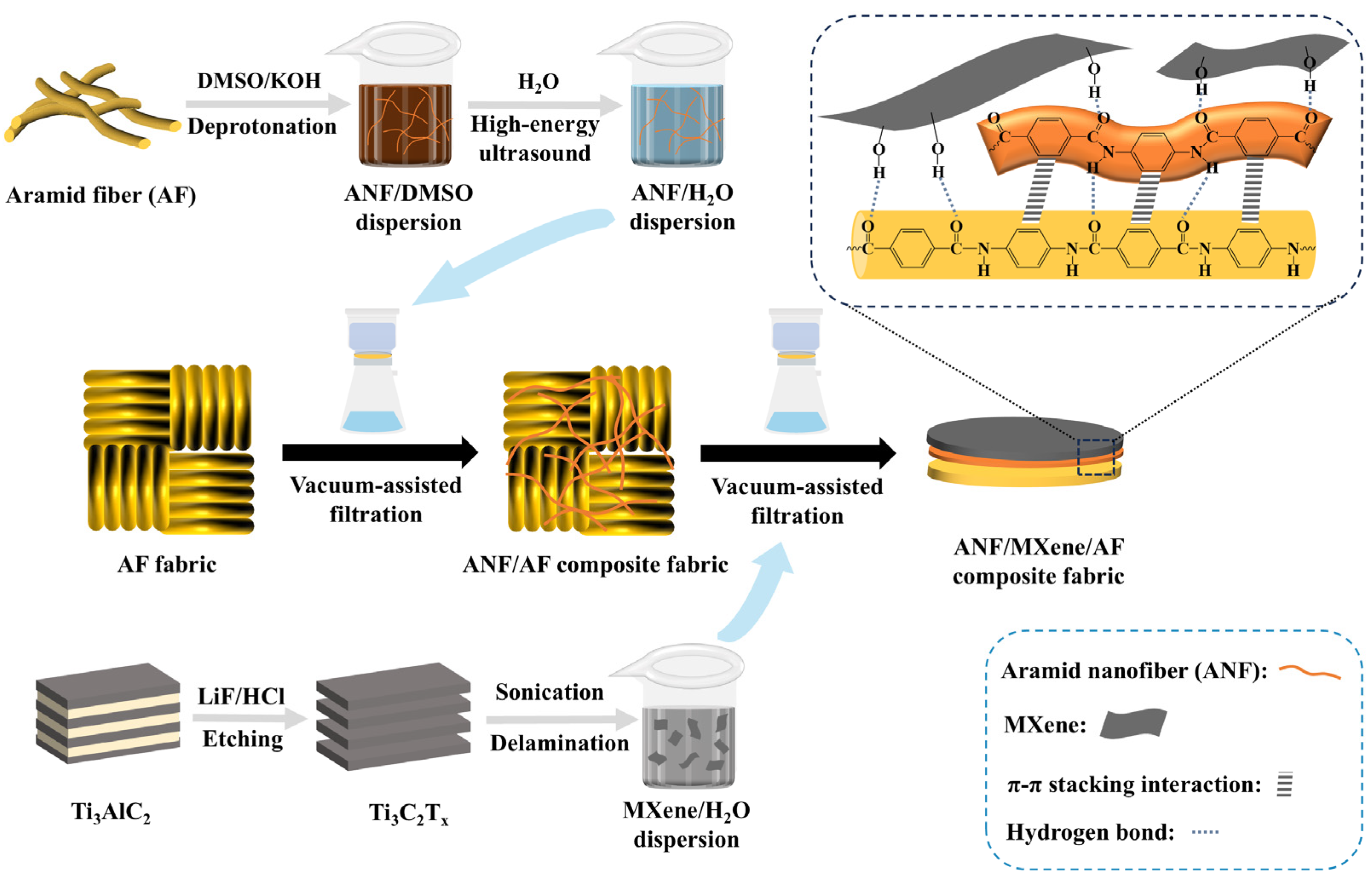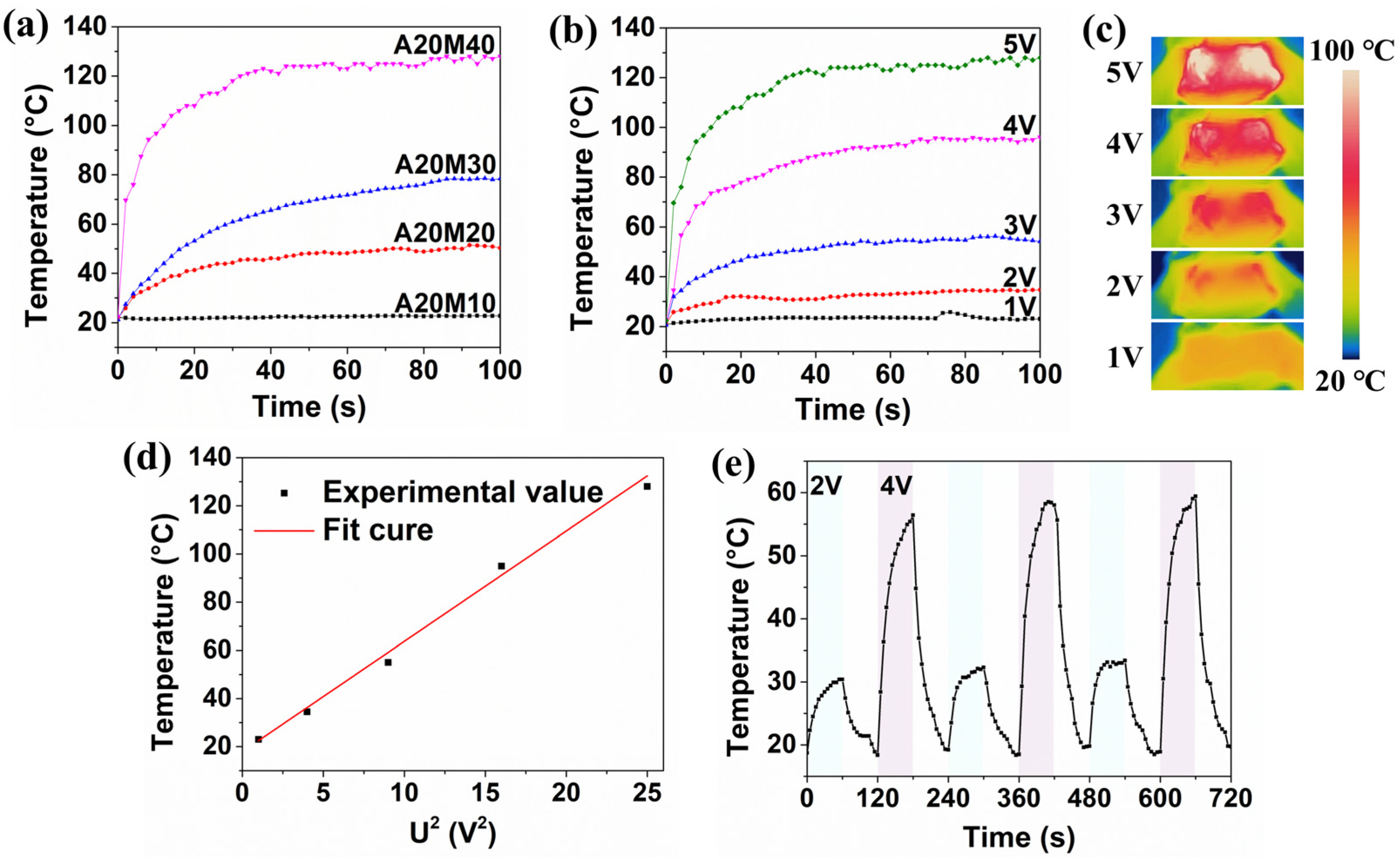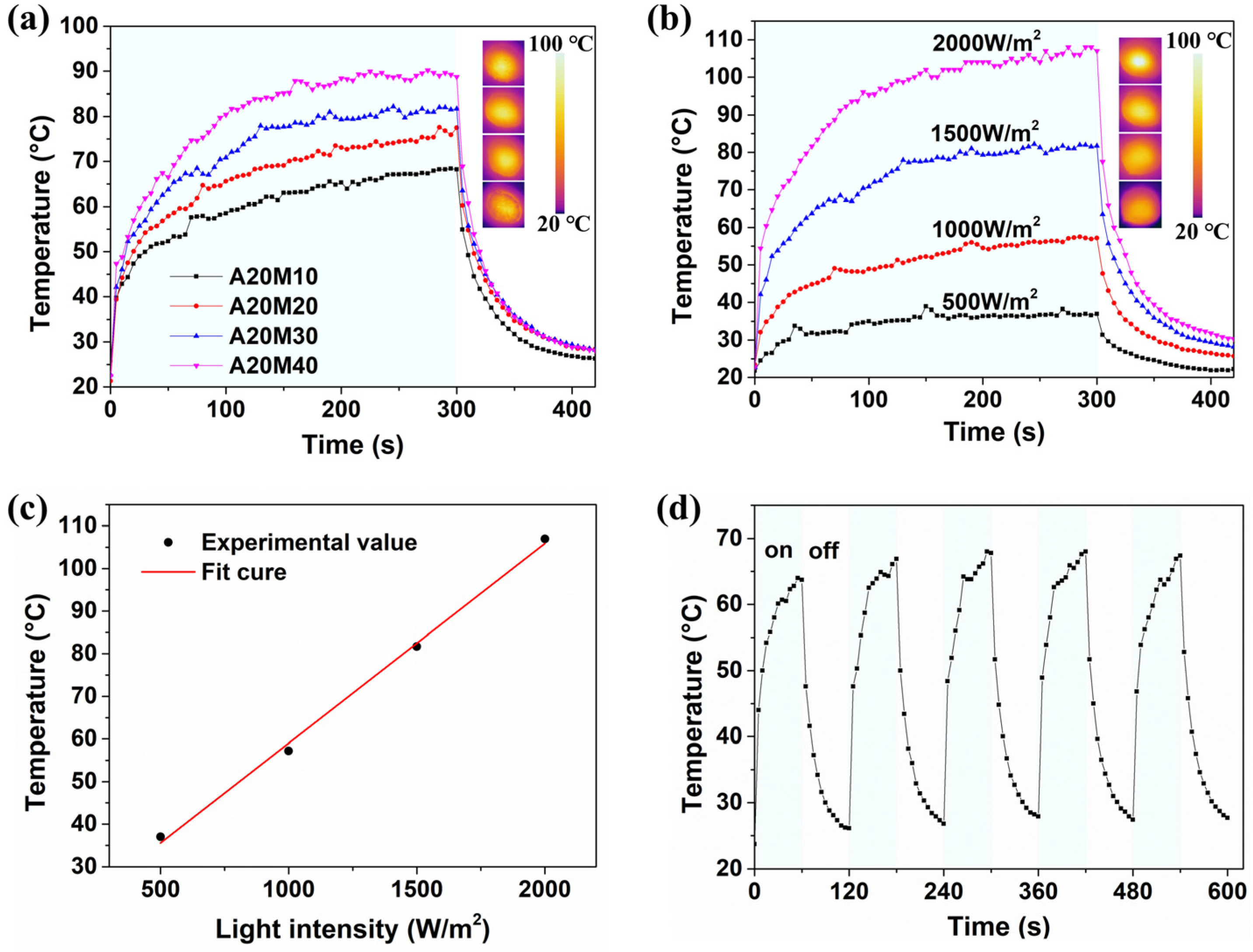Multifunctional Aramid Nanofiber/MXene/Aramid Fiber Composite Fabric with Outstanding EMI Shielding Performance
Abstract
:1. Introduction
2. Materials and Methods
2.1. Materials
2.2. Preparation of ANF
2.3. Preparation of MXene
2.4. Preparation of ANF/MXene/AF Composite Fabric
2.5. Characterization
3. Results and Discussion
3.1. Microstructure of ANF and MXene
3.2. Morphology of ANF/MXene/AF Composite Fabric
3.3. EMI Shielding Performance of ANF/MXene/AF Composite Fabric
3.4. Electrothermal Conversion Performance of ANF/MXene/AF Composite Fabric
3.5. Photothermal Conversion Performance of ANF/MXene/AF Composite Fabric
3.6. Flame Retardancy of ANF/MXene/AF Composite Fabric
4. Conclusions
Author Contributions
Funding
Institutional Review Board Statement
Informed Consent Statement
Data Availability Statement
Conflicts of Interest
Abbreviations
| AF | Aramid fiber |
| EMI | Electromagnetic interference |
| ANF | Aramid nanofiber |
| SE | Shielding effectiveness |
| WPU | Waterborne polyurethane |
| PANI | Polyaniline |
| PEI | Polyetherimide |
| SEM | Scanning electron microscopy |
| DMSO | Dimethyl sulfoxide |
| TEM | Transmission electron microscope |
| XRD | X-ray diffraction |
| FTIR | Fourier transform infrared |
References
- He, A.N.; Xing, T.H.; Liang, Z.H.; Luo, Y.X.; Zhang, Y.; Wang, M.Q.; Huang, Z.Y.; Bai, J.; Wu, L.Y.; Shi, Z.C.; et al. Advanced aramid fibrous materials: Fundamentals, advances, and beyond. Adv. Fiber Mater. 2024, 6, 3–35. [Google Scholar] [CrossRef]
- Tang, J.; Zhang, X.; Wang, J.; Zou, R.L.; Wang, L. Achieving flexible and durable electromagnetic interference shielding fabric through lightweight and mechanically strong aramid fiber wrapped in highly conductive multilayer metal. Appl. Surf. Sci. 2021, 565, 150577. [Google Scholar] [CrossRef]
- Zhang, X.; Tang, J.B.; Zhong, Y.; Feng, Y.J.; Wei, X.P.; Li, M.Y.; Wang, J. Asymmetric layered structural design with metal microtube conductive network for absorption-dominated electromagnetic interference shielding. Colloid. Surface A 2022, 643, 128781. [Google Scholar] [CrossRef]
- Li, Z.; Islam, A.; Khuje, S.; Ren, S.Q. Electrically-driven textiles using hierarchical aramid fiber. Nano Energy 2023, 117, 108888. [Google Scholar] [CrossRef]
- Lee, J.; Lim, J.; Park, K.; Lee, K.; Kim, T.; Lee, W.J. Single-walled carbon nanotube polyelectrolytes with a coherent skin effect for electromagnetic interference shielding. ACS Appl. Nano Mater. 2024, 7, 5776–5783. [Google Scholar] [CrossRef]
- Wang, B.B.; Yin, Z.T.; Cheng, W.H.; Zhang, Y.; Hu, Y. Flame-retardant aramid fabric with durable, self-cleaning, hydrophobic, and tunable electromagnetic interference shielding properties. Compos. Part A Appl. Sci. Manuf. 2023, 166, 107392. [Google Scholar] [CrossRef]
- Wang, X.F.; Lei, Z.W.; Ma, X.D.; He, G.F.; Xu, T.; Tan, J.; Wang, L.L.; Zhang, X.S.; Qu, L.J.; Zhang, X.J. A lightweight MXene-coated nonwoven fabric with excellent flame retardancy, EMI Shielding, and electrothermal/photothermal conversion for wearable heater. Chem. Eng. J. 2022, 430, 132605. [Google Scholar] [CrossRef]
- Li, X.T.; Liu, M.C.; Fang, Y.T.; Wu, Z.Q.; Dong, J.; Zhao, X.; Teng, C.Q. Flexible and efficient MXene/PANI/aramid fabrics with high interface durability for wearable electromagnetic wave shielding. Compos. Commun. 2024, 45, 101776. [Google Scholar] [CrossRef]
- Shi, Y.Q.; Nie, C.X.; Jiang, S.Q.; Wang, H.R.; Feng, Y.Z.; Gao, J.F.; Tang, L.C.; Song, P.A. Tunable construction of fire safe and mechanically strong hierarchical composites towards electromagnetic interference shielding. J. Colloid. Interf. Sci. 2023, 652, 1554–1567. [Google Scholar] [CrossRef]
- Peng, J.; Cheng, H.A.; Liu, J.Y.; Han, W.Y.; Wu, T.; Yin, Y.J.; Wang, C.X. Superhydrophobic MXene-based fabric with electromagnetic interference shielding and thermal management ability for flexible sensors. Adv. Fiber Mater. 2023, 5, 2099–2113. [Google Scholar] [CrossRef]
- Li, X.X.; Zhao, B.X.; Qin, W.J.; Yang, M.; Feng, L.; Gu, C.S.; Tian, Z.H.; Liu, H.C.; Guo, X.J.; Zhang, Y.; et al. MXene Ti3C2Tx, EGaIn, and carbon nanotube composites on polyurethane substrates for strain sensing, electromagnetic interference shielding, and Joule heating. ACS Appl. Nano Mater. 2023, 6, 14459–14468. [Google Scholar] [CrossRef]
- Dong, J.W.; Luo, S.L.; Ning, S.P.; Yang, G.; Pan, D.; Ji, Y.X.; Feng, Y.Z.; Su, F.M.; Liu, C.T. MXene-coated wrinkled fabrics for stretchable and multifunctional electromagnetic interference shielding and electro/photo-thermal conversion applications. Acs Appl. Mater. Inter. 2021, 13, 60478–60488. [Google Scholar] [CrossRef] [PubMed]
- Chen, Y.; Yin, Q.; Zhang, X.M.; Zhang, W.Q.; Jia, H.B.; Ji, Q.M.; Yang, F.F.; Rui, X.T. Rational design of multifunctional properties for styrene-butadiene rubber reinforced by modified Kevlar nanofibers. Compos. Part B Eng. 2019, 166, 196–203. [Google Scholar] [CrossRef]
- Jung, J.; Sodano, H.A. High strength epoxy nanocomposites reinforced by epoxy functionalized aramid nanofibers. Polymer 2020, 195, 122438. [Google Scholar] [CrossRef]
- Li, Y.W.; Peng, S.Q.; Kankala, R.K.; Wu, L.X.; Chen, A.Z.; Wang, S.B. 3D printing of mechanically robust MXene-encapsulated polyurethane elastomer. Compos. Part A Appl. Sci. Manuf. 2022, 163, 107182. [Google Scholar] [CrossRef]
- Huang, Y.; Jiang, S.; Liang, R.; Sun, P.; Hai, Y.; Zhang, L. Thermal-triggered insulating fireproof layers: A novel fire-extinguishing MXene composites coating. Chem. Eng. J. 2020, 391, 123621. [Google Scholar] [CrossRef]
- Zhang, T.Y.; Wang, H.; Tong, J.M.; Zhang, J.G.; Wang, X.H.; Zeng, Y. High-efficiency ultraviolet shielding and high transparency of Ti3C2Tx MXene/poly(vinyl alcohol) nanocomposite films. Compos. Commun. 2022, 33, 101235. [Google Scholar] [CrossRef]
- Zhang, Y.; Wang, L.; Zhang, J.; Song, P.; Xiao, Z.; Liang, C.; Qiu, H.; Kong, J.; Gu, J. Fabrication and investigation on the ultra-thin and flexible Ti3C2Tx/co-doped polyaniline electromagnetic interference shielding composite films. Compos. Sci. Technol. 2019, 183, 107833. [Google Scholar] [CrossRef]
- Thirumal, V.; Yuvakkumar, R.; Kumar, P.S.; Keerthana, S.P.; Ravi, G.; Velauthapillai, D.; Saravanakumar, B. Efficient photocatalytic degradation of hazardous pollutants by homemade kitchen blender novel technique via 2D-material of few-layer MXene nanosheets. Chemosphere 2021, 281, 130984. [Google Scholar] [CrossRef]
- He, G.F.; Wang, L.L.; Bao, X.J.; Lei, Z.W.; Ning, F.G.; Li, M.; Zhang, X.S.; Qu, L.J. Synergistic flame retardant weft-knitted alginate/viscose fabrics with MXene coating for multifunctional wearable heaters. Compos. Part B Eng. 2022, 232, 109618. [Google Scholar] [CrossRef]
- Li, R.; Zhang, L.; Shi, L.; Wang, P. MXene Ti3C2: An effective 2D light-to-heat conversion material. ACS Nano 2017, 11, 3752–3759. [Google Scholar] [CrossRef] [PubMed]
- Zhang, Q.; Shi, T.; Zhu, L.; Cao, N.N.; Chen, X.C. SiO2@MXene-based fabric featuring low heat loss for high-efficiency solar-driven freshwater production. J. Environ. Chem. Eng. 2024, 12, 112658. [Google Scholar] [CrossRef]
- Wang, Y.; Qi, Q.; Fan, J.; Wang, W.; Yu, D. Simple and robust MXene/carbon nanotubes/cotton fabrics for textile wastewater purification via solar-driven interfacial water evaporation. Sep. Purif. Technol. 2021, 254, 117615. [Google Scholar] [CrossRef]
- Zhai, W.Y.; Cao, Y.M.; Li, Y.F.; Zheng, M.; Wang, Z.S. MoO3−x QDs/MXene (Ti3C2Tx) self-assembled heterostructure for multifunctional application with antistatic, smoke suppression, and antibacterial on polyester fabric. J. Mater. Sci. 2022, 57, 2597–2609. [Google Scholar] [CrossRef]
- Yu, B.; Tawiah, B.; Wang, L.Q.; Yuen, A.C.Y.; Zhang, Z.C.; Shen, L.L.; Lin, B.; Fei, B.; Yang, W.; Li, A.; et al. Interface decoration of exfoliated MXene ultra-thin nanosheets for fire and smoke suppressions of thermoplastic polyurethane elastomer. J. Hazard. Mater. 2019, 374, 110–119. [Google Scholar] [CrossRef]
- Shi, Y.; Liu, C.; Duan, Z.; Yu, B.; Liu, M.; Song, P. Interface engineering of MXene towards super-tough and strong polymer nanocomposites with high ductility and excellent fire safety. Chem. Eng. J. 2020, 399, 125829. [Google Scholar] [CrossRef]
- Luo, Y.; Xie, Y.; Jiang, H.; Chen, Y.; Zhang, L.; Sheng, X.; Xie, D.; Wu, H.; Mei, Y. Flame-retardant and form-stable phase change composites based on MXene with high thermostability and thermal conductivity for thermal energy storage. Chem. Eng. J. 2021, 420, 130466. [Google Scholar] [CrossRef]







Disclaimer/Publisher’s Note: The statements, opinions and data contained in all publications are solely those of the individual author(s) and contributor(s) and not of MDPI and/or the editor(s). MDPI and/or the editor(s) disclaim responsibility for any injury to people or property resulting from any ideas, methods, instructions or products referred to in the content. |
© 2025 by the authors. Licensee MDPI, Basel, Switzerland. This article is an open access article distributed under the terms and conditions of the Creative Commons Attribution (CC BY) license (https://creativecommons.org/licenses/by/4.0/).
Share and Cite
Wang, Q.; Wang, Y.; Sun, C.; Zhang, Y.; Qu, R.; Shen, Y. Multifunctional Aramid Nanofiber/MXene/Aramid Fiber Composite Fabric with Outstanding EMI Shielding Performance. Coatings 2025, 15, 354. https://doi.org/10.3390/coatings15030354
Wang Q, Wang Y, Sun C, Zhang Y, Qu R, Shen Y. Multifunctional Aramid Nanofiber/MXene/Aramid Fiber Composite Fabric with Outstanding EMI Shielding Performance. Coatings. 2025; 15(3):354. https://doi.org/10.3390/coatings15030354
Chicago/Turabian StyleWang, Qianyi, Ying Wang, Changmei Sun, Ying Zhang, Rongjun Qu, and Yunxia Shen. 2025. "Multifunctional Aramid Nanofiber/MXene/Aramid Fiber Composite Fabric with Outstanding EMI Shielding Performance" Coatings 15, no. 3: 354. https://doi.org/10.3390/coatings15030354
APA StyleWang, Q., Wang, Y., Sun, C., Zhang, Y., Qu, R., & Shen, Y. (2025). Multifunctional Aramid Nanofiber/MXene/Aramid Fiber Composite Fabric with Outstanding EMI Shielding Performance. Coatings, 15(3), 354. https://doi.org/10.3390/coatings15030354




